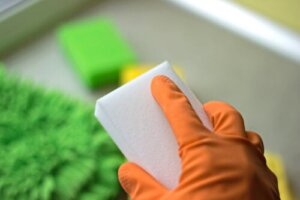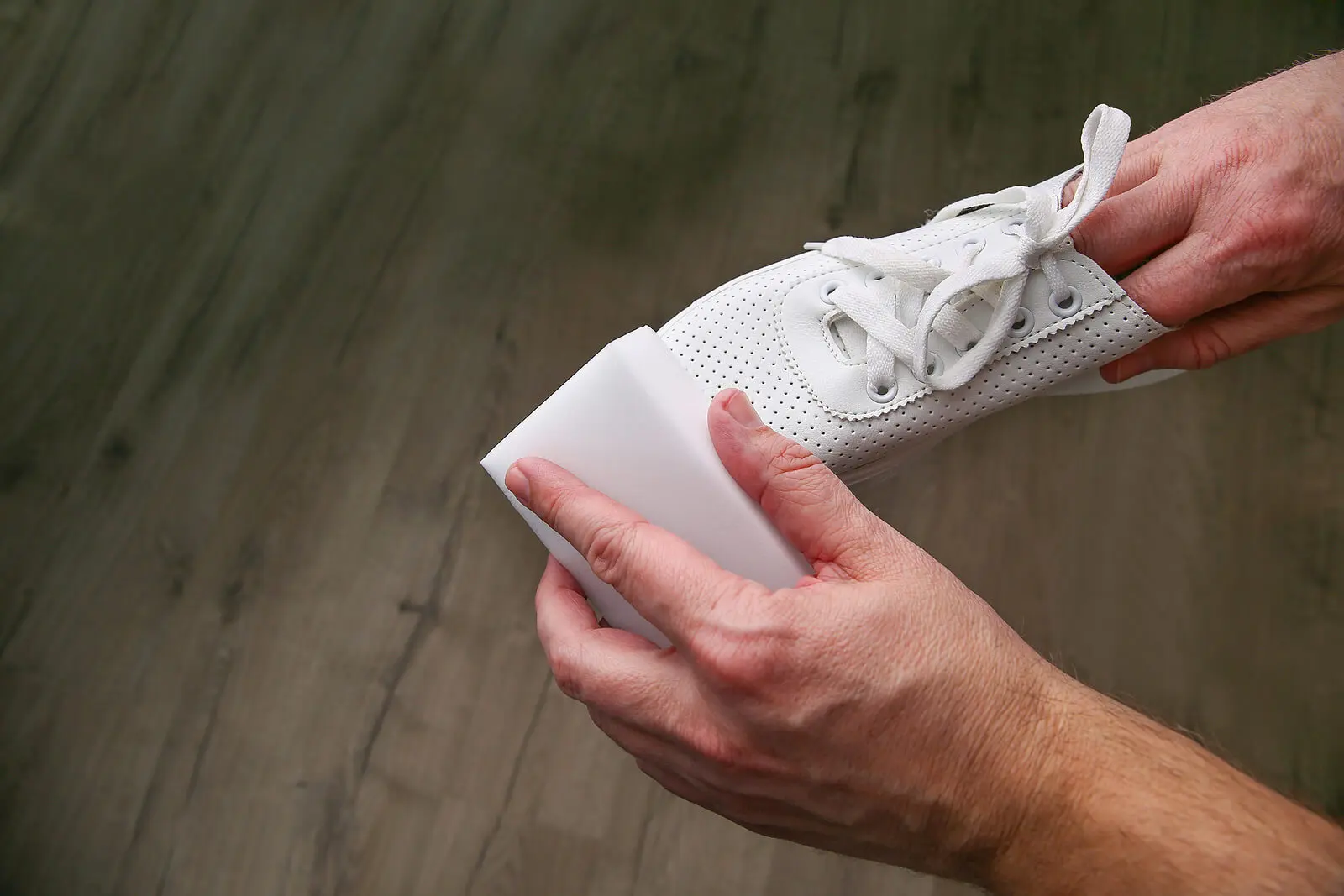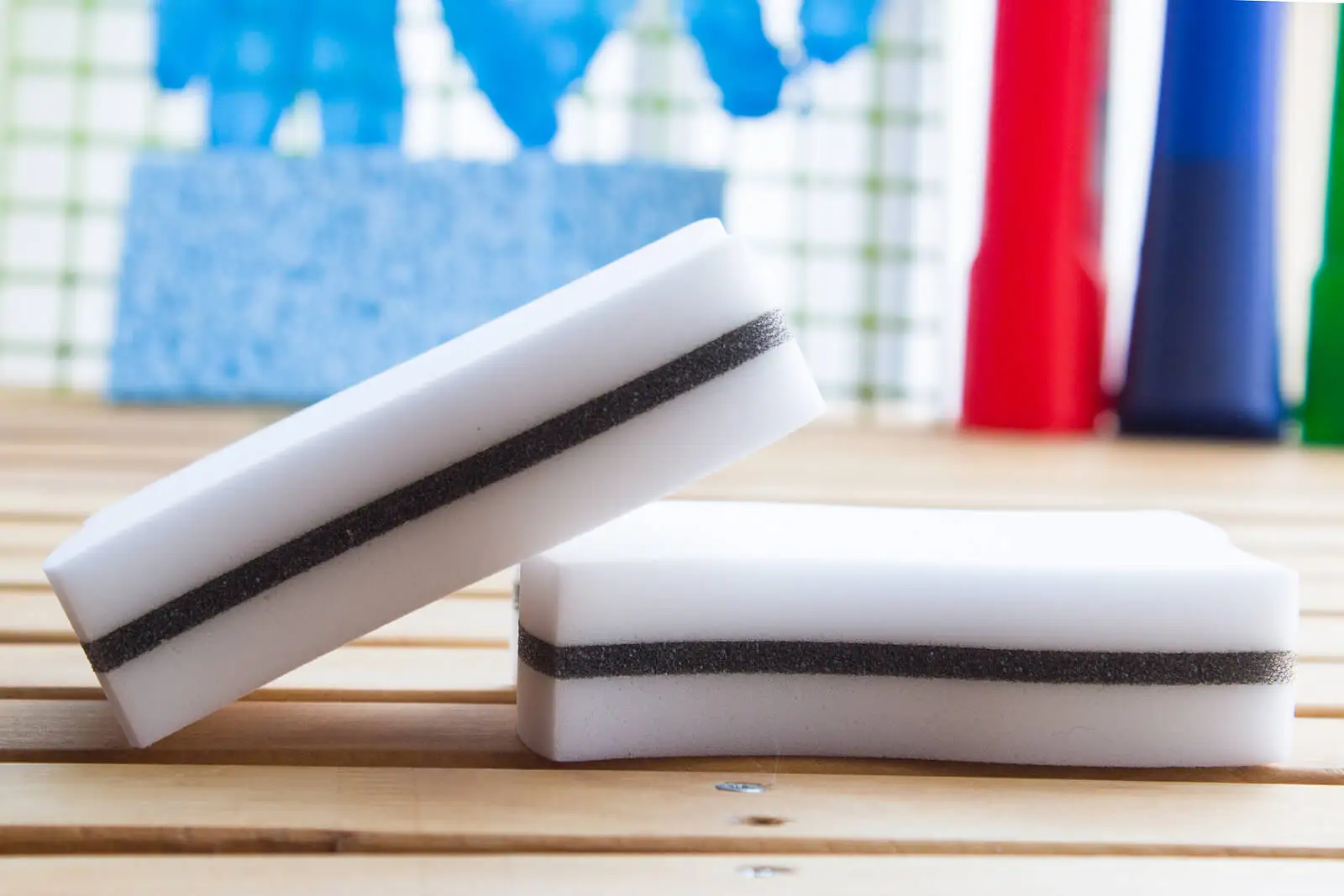Discover What You Can Clean with a Melamine Sponge

“Innovative!” That’s te adjective that characterizes the melamine sponge, an invention with which you can clean everything (or at least many things that you didn’t think you could clean with a sponge). Due to its composition, this instrument can remove stains on the wall, grease stuck to the stove, and rust or dirt stuck on mirrors.
It may seem unlikely, but more and more people, after using it, are convinced of its effectiveness. It turns out that melamine is an effective cleaner, which is activated by the foam. It softens the dirt in the affected area and then absorbs it. So, are you interested in learning more about it? We’ll tell you all about it here.
How to use the melamine sponge
The way to use the melamine sponge may vary depending on the manufacturer. Therefore, the first recommendation is to read the instructions. However, in general, it’s usually suggested to use it without other cleaners. The steps for use are as follows:
- Take the sponge out of its packaging. Then, if you purchased a “maxi” melamine sponge, you can cut it to a size that makes it easier to handle. Make a clean cut in one direction only.
- Wet the sponge with tap water. Remove excess water by squeezing it out with your hand. Do not twist.
- Rub the desired area with the sponges. Make movements as if you were using a pencil eraser. You can go in several directions and use all areas of the product, both flat and sideways.
- Finished carving? Finish by wiping the area with a damp cloth and warm water. In the case of kitchen utensils, you should wash them with soap and water.
Consider discarding the sponge when it is thin or has been used on glass or contaminated surfaces.

We think you may also like to read this article: Luffa Sponges: Benefits and How to Use Them
10 things you can clean with the melamine sponge
Melamine is an organic compound that is moderately soluble in water; therefore, this sponge only needs a little liquid to do its job. Now, let’s discover which surfaces it can clean.
1. Remove stains and scratches on walls
Naughty children at home? Don’t worry; you can restore the look of your walls with the help of the melamine sponge. This product has proven its ability to erase scratches with pens, colors, markers, waxes, and other substances, both on smooth and textured walls.
Thus, its effectiveness also fights mold and mildew stains that may be found on some walls, such as those in the garage or basements, for example. Just be careful how hard you rub the sponge on thin paints; remember that it’s an abrasive sponge.
2. Wash away the traces of stuck-on grease
You don’t clean your stove very often and the result is a sticky surface that takes a long time to clean. The melamine sponge can simplify the job, especially the tedious task of cleaning cast iron burners and grills.
It’s as simple as wiping it over all areas of the stove, not forgetting the sides, the inside of the oven, and, of course, the oven door. You will get a gleaming stove, almost like the day it was first used!
3. Clean dirt from window sills and window frames
Dust and dirt are the order of the day from window sills or window sills. The situation worsens when these surfaces are not cleaned regularly, when bird droppings, pollen, and dust stains start to solidify.
What to do about it? To make them spotless, you can make a mixture of water and soap and dampen the sponge in the solution. All that’s left is to wipe them with a damp microfiber cloth to remove any remaining scum.
4. Polish mirrors and glass with rust
The melamine sponge is ideal for cleaning old mirrors. These often harbor stubborn stains, such as rust. You may have already tried everything, vinegar, soap, bleach, etc… However, surely you haven’t tried this tool!
Note: after using it on glass you should discard it, as it tends to remove a thin layer of the glass.
5. Wash cirty or marked skirting boards and baseboards
Skirting boards are often left aside during quick cleanings, so they accumulate grease, dust, and food debris. As a result, they become yellowish, especially over time. Baseboards, being on the lower part of the wall, are usually not attractive to clean as it involves bending down.
However, there comes a time when you can’t overlook them because they are so badly worn. The best way to recover them without applying much effort is to clean them with a melamine sponge. The results can be seen instantly!
6. Clean white rubber on sneakers
Do you want to recover the whiteness of the rubber of your shoes? Easy! Just rub the affected area with the melamine sponge and that’s it; the yellowish and dirty part will be gone. After scrubbing with the sponge, it is recommended to dry with kitchen paper.
If you’re also looking to remove the white fabric of the sneakers, prepare a mixture of baking soda, salt, and white vinegar. Then, scrub it with a sponge – you’ll be amazed at the finish!
7. Joints of tiles, ceramics, and others
Tile joints often accumulate mold, mildew, black stains, and grease, depending on the area of the house where they are located. There are many measures and products to remedy this. However, these sponges will make the task easier in just a few minutes.
8. Smut or burnt pots and pans
In some kitchens, pots, and pans accumulate grease and smut. These, in turn, burn after putting them on the stove. The result? Bad-looking cookware.
However, if they’re made of stainless steel, you can restore their shine with the melamine sponge. In fact, it also works on stained and yellowed plastic containers.
9. Remains of glue or stickers
Moisten the sponge and rub it over the affected area; in a few minutes, the glue will soften. This is ideal for removing labels from glass jars that you want to reuse. This will prevent dirt and germs from being left on the surface.
10. Gold and silver
Looking to keep your jewelry in shape? This sponge can help you polish them. Just be sure to dry them thoroughly when you’re done washing them. Rinse them with plenty of water and dry them with a clean cloth.
Other items you can clean with a melamine sponge
In addition to the above, there are other items that can be cleaned with this type of sponge. The best part? It’s an environmentally friendly item, since it’s not made of toxic chemicals. Go ahead and try it!
- Seats, handbags, and chairs made of leather. Before reupholstering or replacing, try cleaning them with this element.
- Faucets, pipes, sinks, showers, or toilets full of limescale or dirt.
- Stained teacups. Remember to wash them properly after removing the stain.
- Old and rusty bicycles. You can restore their shine.
- Garden furniture and terraces. Being outdoors, they tend to get dirty. Fortunately, it’s enough to rub this sponge regularly to improve their appearance.
- Objects with enamel stains. You will be able to fight them in a few minutes on most surfaces.
5 surfaces you shouldn’t clean with the melamine sponge
Despite its many uses in household cleaning, the melamine sponge should not be used on certain surfaces. The reason? Its abrasiveness can ruin them. Take note.
1. Computer, tablet, and TV screens
Beware! Electronic screens are delicate and can suffer scratches if they are cleaned with this type of sponge. In these cases, the best option is a microfiber cloth.
2. Non-stick pans
The thin coating that covers non-stick pans and pots can deteriorate if rubbed with this element. They will no longer perform their primary function and food will start to stick.
3. Glass ceramic
Glass-ceramic is another delicate surface. Both melamine sponge and other abrasives can ruin your glass.
4. Wooden furniture and surfaces
Wooden furniture should be cleaned with products designed for wood. The magic sponge is not the case, as it will scratch or alter your finish. Instead, try DIY recipes.
5. The body of a car
Yes, we know there are some tips around the Internet for cleaning the car body with a melamine sponge. But instead of getting rid of existing marks on this surface, you could make it worse. Make a safe decision; remember that damage can become irreversible.

We think you may also like to read this: The Hidden Dangers in Kitchen Sponges
Can melamine sponges be harmful to health?
As long as its uses are limited to household cleaning, this sponge is considered safe. However, it’s worth mentioning that there are situations where they do pose a risk. For example, a viral challenge on TikTok proposes its use for teeth whitening.
The downside is that repeated use alters tooth enamel and increases the risk of stains and disease. As a study in the journal Plos One details, as dentin is exposed, there is a greater chance of developing tooth decay.
Keep manufacturer’s warnings in mind
Do not under any circumstances skip the manufacturer’s prohibitions, especially those that warn of surfaces not to be used on or those that involve contact with foodstuffs. That said, you can start taking advantage of the many uses of melamine sponges in the home.
Whenever you apply it to fragile surfaces, do so without applying too much pressure. Generally, results can be noticed by simply rubbing the item with gentle movements. Don’t worry if the sponge starts to crumble, that’s normal – it will still leave everything sparkling!
All cited sources were thoroughly reviewed by our team to ensure their quality, reliability, currency, and validity. The bibliography of this article was considered reliable and of academic or scientific accuracy.
- Niu H, Qiang Z, Ren J. Durable, magnetic-responsive melamine sponge composite for high efficiency,in situoil-water separation. Nanotechnology. 2021 Apr 14;32(27). doi: 10.1088/1361-6528/abef2e. PMID: 33725679.
- Toothman, J. (Jul 22, 2021). “Melamine Foam”. HowStuffWorks. Available in https://home.howstuffworks.com/magic-eraser.htm#pt1
- Vieira AR, Gibson CW, Deeley K, Xue H, Li Y. Weaker dental enamel explains dental decay. PLoS One. 2015 Apr 17;10(4):e0124236. doi: 10.1371/journal.pone.0124236. PMID: 25885796; PMCID: PMC4401694.
This text is provided for informational purposes only and does not replace consultation with a professional. If in doubt, consult your specialist.








